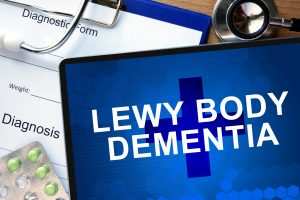 Lew body dementia (LBD) is an umbrella term referring to both Parkinson’s disease dementia and dementia with Lewy bodies. In dementia with Lewy bodies, cognitive symptoms interfering with daily living present themselves before or within one year of Parkinson’s-like movement problems. In Parkinson’s disease dementia, cognitive symptoms usually don’t appear until after a year of the onset of movement problems.
Lew body dementia (LBD) is an umbrella term referring to both Parkinson’s disease dementia and dementia with Lewy bodies. In dementia with Lewy bodies, cognitive symptoms interfering with daily living present themselves before or within one year of Parkinson’s-like movement problems. In Parkinson’s disease dementia, cognitive symptoms usually don’t appear until after a year of the onset of movement problems.
Researcher Howard I. Hurtig explained, “An early and accurate diagnosis may be lifesaving. The avoidance of medications that can worsen the symptoms of LBD cannot be overemphasized. Every patient with LBD and their caregiver(s) should memorize the list of acceptable and forbidden drugs.”
Advertisement
Lewy body dementia is characterized by an abnormal buildup of Lewy bodies in areas of the brain responsible for memory, behavior, movement, and personality. Parkinson’s disease symptoms primarily affect mobility and motor abilities. Diagnosis can be difficult because more than one cognitive disorder can be causing changes in the brain. For proper diagnosis and differentiation between dementia and Parkinson’s disease, it’s best to consult with a neurologist or geriatric physician.
Signs and symptoms of dementia with Lewy bodies and Parkinson’s disease dementia
Parkinson’s disease dementia
- Changes in memory, concentration, or judgement
- Trouble interpreting visual information
- Muffled speech
- Visual hallucinations
- Delusions, paranoid thoughts
- Depression
- Irritability and anxiety
- Sleep disturbances
- Loss of decision-making ability
- Disorientation in familiar surroundings
- Trouble learning new material
- Difficulty using complex language
Dementia with Lewy bodies
- Changes in thinking and reasoning
- Confusion and alertness that varies significantly
- Parkinson’s symptoms
- Visual hallucinations
- Delusions
- Trouble interpreting visual information
- Acting out dreams
- Memory loss
As you can see, Parkinson’s disease dementia and dementia with Lewy bodies share many signs and symptoms. It’s important that a specialist reviews the patient’s specific symptoms to establish a proper diagnosis and recommend an appropriate mode of treatment.
